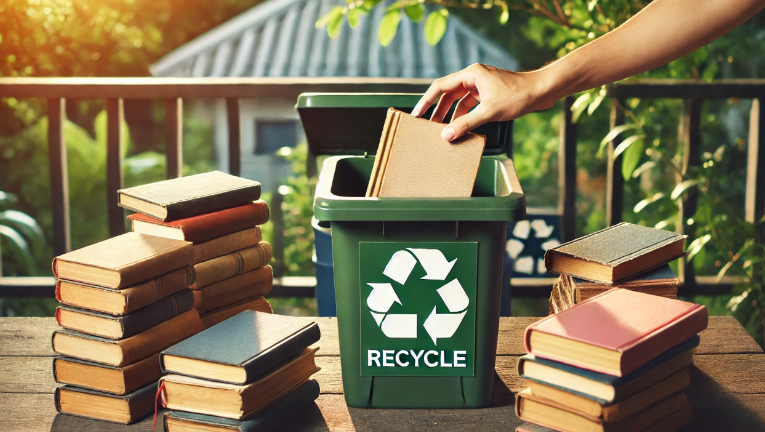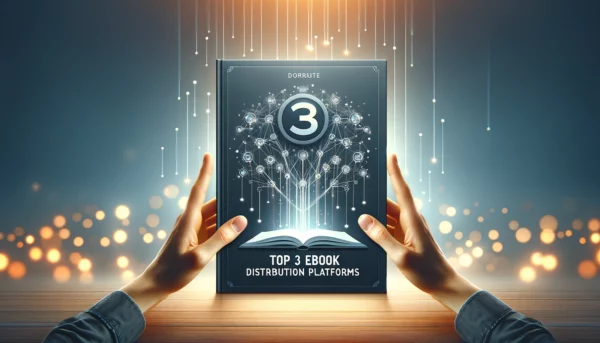Let’s face it: the publishing industry hasn’t exactly been known for its eco-friendly practices. In a world where we’re all trying to be a bit greener—swapping out plastic straws, cycling to work, and even mastering the art of reusable coffee cups—book printing still lags. The paper industry alone is responsible for about 10% of deforestation worldwide, contributing to habitat destruction and carbon emissions that would make a coal plant blush. But here’s the good news: it doesn’t have to be this way.
Authors have more control than they think when it comes to how their books are printed, and choosing sustainable methods is one of the best ways to ensure your story isn’t leaving a heavy environmental footprint. From recycled paper to eco-friendly inks, there are plenty of options to help your book stand out on the shelf without compromising the planet. So, if you’ve ever wondered how to print books without printing guilt, you’re in the right place. Let’s look at five sustainable book printing methods every author should know.
Why Sustainability Matters in Book Printing
Imagine this: your book finally gets printed, and it’s a beautiful, crisp volume with your name shining on the cover. But behind that glossy finish lies a not-so-glamorous truth—the traditional printing process has a hefty environmental price tag. Conventional book printing involves high energy usage, deforestation, and a mix of chemicals that can harm our air and water. It’s not exactly the greenest way to share your story with the world.
Your Publishing Journey Awaits – Start NowThe good news? Sustainable printing practices are on the rise, and you, as an author, can make a big difference. By choosing eco-friendly methods, you can help reduce the carbon footprint of your book, support recycling initiatives, and even save a few trees along the way. According to a report by the Environmental Paper Network, the paper industry is responsible for 40% of the global wood harvest, but recycling just one ton of paper can save 17 trees, 7,000 gallons of water, and enough energy to power an average home for six months. That’s a lot of impact for one book!
Sustainability in printing isn’t just about reducing waste; it’s about taking a more responsible approach to production. By opting for greener options, you’re not only showing your commitment to the environment, but you’re also appealing to the growing number of eco-conscious readers who care about how their books are made.
Recycled Paper: Reducing Waste and Supporting Recycling
Let’s start with one of the easiest ways to make your book printing more eco-friendly: using recycled paper. Traditional paper production is resource-intensive, consuming large amounts of water, energy, and, of course, trees. But by opting for recycled paper, you’re giving new life to paper that has already served its purpose, significantly reducing the need for virgin materials.
What Is Recycled Paper?
Recycled paper is made from post-consumer waste—like old newspapers, office paper, and discarded books. Instead of ending up in a landfill, these materials are collected, processed, and turned into fresh, new sheets of paper ready for printing. It’s a win-win: less waste, fewer trees cut down, and lower energy consumption.
Choosing recycled paper can make a big difference. Producing recycled paper uses 50% less water and 40% less energy compared to making new paper. Plus, every ton of recycled paper saves about 17 trees, which might not sound like much until you consider how many books are printed each year. Imagine the environmental impact if more authors and publishers made the switch!
Certifications to Look For
Not all recycled paper is created equal, so it’s important to check for certifications that guarantee you’re getting the real deal. The Forest Stewardship Council (FSC) certification is one of the most recognized, ensuring that the paper comes from responsibly managed forests and recycled sources. The Programme for the Endorsement of Forest Certification (PEFC) is another trusted label to look for. By choosing FSC or PEFC-certified recycled paper, you’re supporting sustainable forestry and responsible manufacturing practices.
Practical Tips for Authors
As an author, you might think that choosing recycled paper is out of your control, but it’s easier than you think. When discussing printing options with your publisher, or if you’re self-publishing, ask about the availability of recycled paper. Many printers now offer it as a standard option, and some even provide different grades of recycled paper to suit your book’s needs—whether it’s a glossy finish for a coffee table book or a more rustic, uncoated paper for a novel.
Switching to recycled paper might cost a little more upfront, but the environmental benefits are well worth it. Plus, you’ll be giving your readers another reason to support your work, knowing that their purchase is helping to preserve the planet.
Reducing Carbon Footprint with Digital Printing
Gone are the days when printing a book meant producing thousands of copies and hoping they’d all sell. Today, digital printing has revolutionized the industry, making it easier, faster, and—best of all—more eco-friendly. Unlike traditional offset printing, which requires setting up plates and running large presses, digital printing uses a digital file to print directly onto the paper. This not only streamlines the process but also cuts down on waste, energy use, and carbon emissions.
What Makes Digital Printing Greener?
Traditional printing involves long setups, which means significant energy consumption, large amounts of ink, and paper wastage—especially if you only need a few hundred copies. Digital printing, on the other hand, eliminates much of this waste. It allows you to print smaller runs, reducing overproduction and making it easier to adjust the quantity based on demand. Studies have shown that digital printing produces 90% less waste compared to traditional methods. That’s a massive cut in the environmental footprint.
The Advantages of Print-on-Demand (POD)
One of the best features of digital printing is Print-on-Demand (POD). This means your book is only printed when someone orders it, ensuring that no unsold copies are sitting in warehouses, gathering dust, and ultimately ending up as waste. POD is perfect for self-published authors or those with smaller audiences who want to avoid the high upfront costs of bulk printing. Companies like IngramSpark and Amazon’s KDP have made it possible for authors to use POD services, keeping costs low and sustainability high.
Your Publishing Journey Awaits – Start NowSince digital printing setups are faster and use less energy, they also produce fewer carbon emissions. According to a report by Smithers, digital printing technology has a smaller carbon footprint, with lower energy consumption and reduced use of chemicals like solvents. This makes it a much more sustainable choice for eco-conscious authors who want to minimize their impact on the environment.
Why Should You Consider Digital Printing?
If you’re self-publishing, opting for digital printing can give you greater flexibility, allowing you to print small batches, test different versions, or update your book without reprinting the entire stock. This reduces waste and saves resources. Additionally, many digital printers now use eco-friendly, vegetable-based inks and recycled paper, further boosting their green credentials.
In the world of sustainable book printing, digital printing is a game-changer. It’s efficient, adaptable, and most importantly, environmentally friendly. So, if you’re looking to minimize your book’s carbon footprint and still produce a high-quality product, digital printing is a great choice.
Using Vegetable-Based Inks: A Greener Alternative
Traditional inks are often petroleum-based, containing chemicals that can harm the environment. A more sustainable option is vegetable-based inks, made from renewable plant oils like soy, linseed, and corn. These inks are biodegradable, produce fewer volatile organic compounds (VOCs), and make the recycling process cleaner.
Why Switch?
Vegetable-based inks are not only eco-friendly but also deliver bright, vivid colors and crisp text. For instance, soy-based inks can cover 15% more paper than petroleum inks, reducing overall usage. Plus, they break down naturally, minimizing environmental impact.
Examples of Green Printers
If you’re self-publishing, ask your printer if they offer vegetable-based options. Many green printers now provide these as standard, helping authors lower their environmental footprint while maintaining print quality.
Eco-friendly printers like Greenerprinter, EarthColor, and PrintNatural are known for using vegetable-based inks as part of their sustainable printing practices. These companies prioritize reducing environmental impact by combining green inks with recycled paper and energy-efficient processes, making it easier for authors to print sustainably.
Volatile Organic Compounds (VOCs): Choosing Low-VOC or VOC-Free Inks
Volatile Organic Compounds, or VOCs, are chemicals found in many traditional inks that can evaporate into the air, contributing to air pollution and health issues. Fortunately, there are low-VOC and VOC-free ink options that offer a more sustainable way to print books without compromising on quality.
Why Are VOCs a Problem?
VOCs can release harmful fumes during the printing process, leading to poor indoor air quality and environmental damage. They also make it harder to recycle printed materials, as the chemicals can contaminate the recycling stream. Reducing VOCs helps cut down on air pollution and promotes safer, cleaner printing environments.
Low-VOC and VOC-Free Ink Options
Low-VOC inks contain fewer harmful chemicals, making them a more environmentally friendly choice. VOC-free inks, often water- or vegetable-based, take this a step further by eliminating these compounds. These inks are better for the environment, easier to handle, and safer for workers.
If you’re aiming to reduce your book’s environmental footprint, ask your printing provider about low-VOC or VOC-free inks. Many eco-conscious printers now offer these as part of their green printing services, helping you create a more sustainable product without sacrificing print quality.
Opting for low-VOC or VOC-free inks is a simple switch that can have a big impact on reducing air pollution and improving sustainability in the book printing process.
Renewable Energy in Book Printing: Powering Green Printing Processes
One of the most effective ways to make book printing more sustainable is by using renewable energy. Traditional printing processes can consume a lot of electricity, often derived from fossil fuels, which increases the carbon footprint. However, more printers are now turning to renewable energy sources like solar, wind, and hydropower to run their operations.
Why It Matters?
Switching to renewable energy reduces greenhouse gas emissions and supports a cleaner, more sustainable printing industry. For example, some print facilities use solar panels to power their machines, cutting down on energy costs and reliance on non-renewable resources. According to the U.S. Department of Energy, solar energy can save nearly 2,300 pounds of carbon emissions per household per year. Imagine the impact on a large printing facility!
How Can You Support Green Energy Printing?
Authors can look for printing companies that prioritize renewable energy as part of their green practices. Printers like PurePrint and Green Press use renewable energy, making them great options for eco-conscious authors looking to minimize their book’s environmental impact.
Sourcing Paper from Responsibly Managed Forests
One of the biggest concerns in book printing is deforestation, but it’s possible to reduce this impact by choosing paper from responsibly managed forests. These forests are managed with sustainability in mind, ensuring that trees are replanted, and ecosystems are preserved.
Why Choose Certified Paper?
Look for certifications like the Forest Stewardship Council (FSC) and the Programme for the Endorsement of Forest Certification (PEFC). These labels guarantee that the paper comes from forests managed to protect wildlife habitats, biodiversity, and the rights of local communities. According to the FSC, responsible forestry can even help combat climate change by maintaining carbon-storing trees.
Your Publishing Journey Awaits – Start NowWhen printing your book, ask your printer if they offer FSC or PEFC-certified paper. Many eco-friendly printers, such as Green Press and Greenerprinter, include this option, allowing authors to reduce their environmental footprint while supporting sustainable forestry practices. By choosing certified paper, you can help ensure that your book doesn’t contribute to habitat loss or irresponsible logging.
Final Thoughts: Printing for a More Sustainable Future
Sustainable book printing is not just a trend—it’s a necessity. By choosing eco-friendly methods like recycled paper, digital printing, vegetable-based inks, low-VOC options, and renewable energy, authors can play a key role in reducing the environmental impact of publishing. Small choices, like selecting certified paper from responsibly managed forests, can make a big difference.
As an author, you have the power to print your books sustainably, offering readers a product they can enjoy without harming the planet. So, the next time you’re ready to publish, consider these green practices and help create a more sustainable future, one book at a time.
Spines & Eco-Friendly Publishing?
While Spines isn’t specifically a sustainable platform, it offers features that can help reduce the environmental impact of book printing. By leveraging AI technology, Spines streamlines the publishing process, reducing the need for multiple drafts, reprints, and excessive use of resources. Additionally, Spines’ print-on-demand (POD) services ensure that books are only printed when they’re ordered, cutting down on waste and minimizing the need for storage and overproduction. This approach not only helps authors save money but also supports a more eco-friendly way of bringing books to market, making it a smarter choice for today’s environmentally conscious authors.
Schedule a free 15-minute call with one of our experts to find out more.
Your Publishing Journey Awaits – Start Now






